Schon vor ein paar Wochen sind neue Rechtschreibregeln rausgekommen, und ich hab’s gar nicht mitbekommen! Das hätte ich mir als rechtschreibfixierter Jungspund nicht träumen lassen.
Nach der Grundschule erfüllte mich noch kindischer Stolz, in allen Diktaten insgesamt nur soundsoviel Fehler gemacht zu haben, und 1996 habe ich den neuen Duden verschlungen, sobald ich ihn in die Finger bekam. Neue Regeln, geil! Für mich war das der heiße Scheiß. Die Doppel-S-Regelung, mutig! „Kennen lernen“, Wahnsinn!
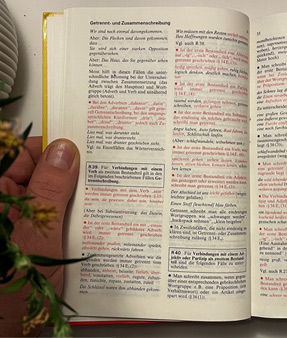
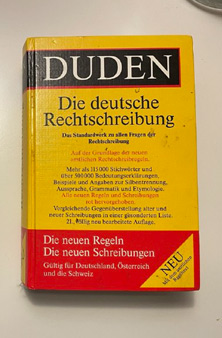
Heute? Die Zeiten sind vorbei, ohne nachzudenken die korrekte Schreibweise zu wissen und recht zu haben. Alles mögliche, pardon!, alles Mögliche muss ich nachschlagen – inklusive „recht haben“ eben gerade. Aha: In grauer Vorzeit gab es nur „recht haben“, dann war ausschließlich „Recht haben“ korrekt, irgendwann war „recht haben“ wieder im Game und jetzt ist das die empfohlene Schreibweise. Bei den alten Regeln musste man auch ein paar Merkwürdigkeiten auswendig können, aber wenigstens waren die überschaubar und eindeutig.
Oder „auswändig“ können? Nein, Quatsch, das galt ja nur von 1996 bis zweitausend-leckmichamarsch…

Jetzt ist also „gefaked“ offiziell erlaubt, wenn auch mit der schönen Einschränkung, dass es in flektierten Formen natürlich „gefakt“ heißen muss – gefakte Schlagzeilen, gefakter als du usw.
Daran werden sich bestimmt alle halten. Für 2030 sage ich voraus:
| Präsens | Präteritum | Konjunktiv I | Konju… | |
|---|---|---|---|---|
| 1. Pers. Sg. | ich fake | ich fakede | Okay, | |
| 2. Pers. Sg. | du fakesed | du fakedesed | langt | |
| 3. Pers. Sg. | sie faked | sie fakede | ||
| 1. Pers. Pl. | ich fake | wir fakeden | ||
| 2. Pers. Pl. | ihr faked | ihr fakeded | ||
| 3. Pers. Pl. | sie faken | sie fakeden |
Vielleicht kristallisiert sich mit der Zeit ja noch eine elegantere Lösung heraus? Ich wäre für die Isolierung des Fremdwortteils durch Kopplungen: ich fake-e, du fake-st, ge-fake-t!
A piece I made for the 50 years of Teletext art exhibition to be aired on Finnish station Yle TV.
1974 marks the birth of a very British invention (Teletext) and a very German invention, too… :)
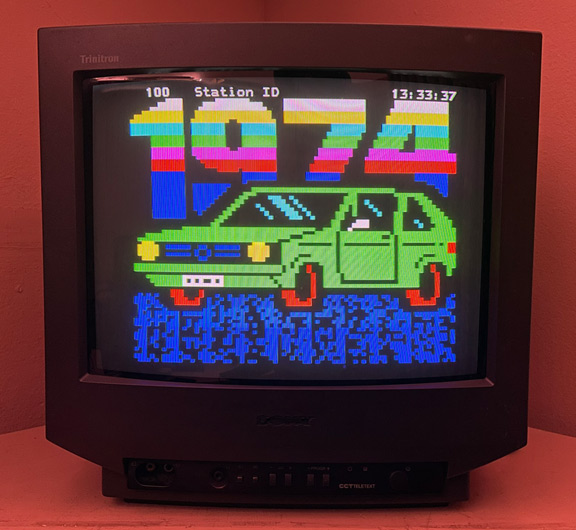
Source code as editor link.
The other day, the question came up: What does the Revision logo mean?

I am curious about that, too – I had already been pondering about the deeper meaning in 2013 (see the source code of doppelhirn):
// I always assumed the revision logo contains an encoded string in // the 5 bits used. Either I am missing something, or that string is // "FDLNDFEAEMLFDF DLFBRSP". var logo = " 0 000000 "+ "000000000000000000000000000000000000"+ " 000000 00 0 0 0 00"+ " "+ "000000000000000000000000000000000000"+ " 000000 000000000 0000000000"+ " 0 00 000 "+ " 0000 "+ "000000000000000000000000000000000000";
IIRC, when I asked around back then, the answer was “it’s nothing specific, it should just look cool”.
Anticipating, nay!, fearing a definite answer in the Revision orga chat where the question came up again, I wanted to have another shot at it before the mystery was revealed.
Break the cycle, erm, circle
The logo consists of concentric circles and looks like it may contain a bunch of rotary encoded bits:

I was already halfway into writing a tool to extract the possible bit combinations when it dawned on me: Un-circle an image to a rectangular representation? That’s a polar coordinate conversion, and there’s a Photoshop filter for that!
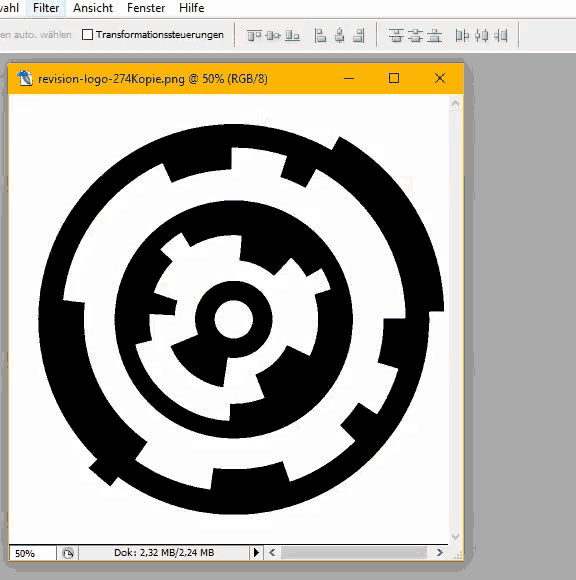
What the bits
First observation: This doesn’t seem to be very regular, neither horizontally nor vertically:

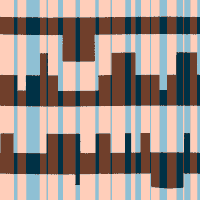
Second observation: My code representation was all wrong! Well, at least not completely accurate, but I think nobody noticed…
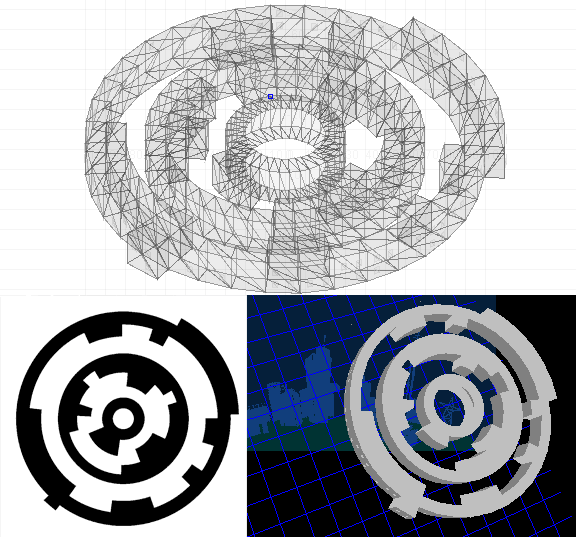
Thirdly, I’m really starting to think there’s no hidden message encoded in the logo… But let’s look at the bits.
Errm… Which bits, exactly? Shall we omit the columns full of ones resp. zeroes? Do we ignore the slight overlap in the center?

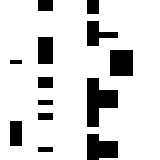
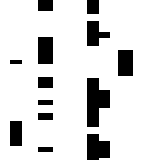
What are we even looking for? An ASCII string? Relative to which character, shall we interpret 00001 as A?
You decide! I think I’ve spent way too much time on this, and all I got was “EGOWUQUMEGOGEMABZJIMOGEAEM”. :)
Bit fiddler
Search for a deeper meaning yourself if you have JavaScript enabled…
| Source bits | Effective bits | Hex | Decimal | As character |
|---|---|---|---|---|
01001100010 |
0000000000 |
00 |
0 | 00 = A |
01001111010 |
0000000000 |
00 |
0 | 00 = A |
01101111010 |
0000000000 |
00 |
0 | 00 = A |
11001111010 |
0000000000 |
00 |
0 | 00 = A |
11001100010 |
0000000000 |
00 |
0 | 00 = A |
11001000010 |
0000000000 |
00 |
0 | 00 = A |
11001100010 |
0000000000 |
00 |
0 | 00 = A |
01101100010 |
0000000000 |
00 |
0 | 00 = A |
01001100010 |
0000000000 |
00 |
0 | 00 = A |
01001111010 |
0000000000 |
00 |
0 | 00 = A |
01101111010 |
0000000000 |
00 |
0 | 00 = A |
01001111010 |
0000000000 |
00 |
0 | 00 = A |
01001100010 |
0000000000 |
00 |
0 | 00 = A |
01101100010 |
0000000000 |
00 |
0 | 00 = A |
01001000010 |
0000000000 |
00 |
0 | 00 = A |
01001001110 |
0000000000 |
00 |
0 | 00 = A |
11101001110 |
0000000000 |
00 |
0 | 00 = A |
01101001110 |
0000000000 |
00 |
0 | 00 = A |
01101000010 |
0000000000 |
00 |
0 | 00 = A |
01101100010 |
0000000000 |
00 |
0 | 00 = A |
01101111010 |
0000000000 |
00 |
0 | 00 = A |
01001111010 |
0000000000 |
00 |
0 | 00 = A |
01001100010 |
0000000000 |
00 |
0 | 00 = A |
01001000010 |
0000000000 |
00 |
0 | 00 = A |
01001100010 |
0000000000 |
00 |
0 | 00 = A |
01101100010 |
0000000000 |
00 |
0 | 00 = A |
Issue #23 of Pixel Addict Magazine contains a large Teletext special celebrating the 50th Teletext anniversary, and I am featured as one of six “teletext aficionados”, talking about the background of Worms VBI a little. ¡Fabuloso!
Besides the juicy Teletext special, there are articles about game development for the NES, early 1980s “slabtop” computers, and many more. Recommended to every retro lover!
PS: Is it “Teletext” or is it “teletext”? I’ve been using Telext in capitalized form everywhere to denote the general technology. Watching the (excellent!) Teletext @50 documentary, I’ve learned that there’s a difference between Teletext and teletext: Teletext with a capital T refers to Teletext Ltd., a teletext provider from 1993. Confusing, but also defunct since 2010 – I think I’ll stick to “Teletext”, as that seems common as well, and Teletext has been a capital influence on my creative shenanigans. :)
I don’t want to start a series about IDE bashing – I love my IntelliJ as much as it loves spaces instead of tabs. And I applaud the effort to help me with grammar, style, and wordiness! But:
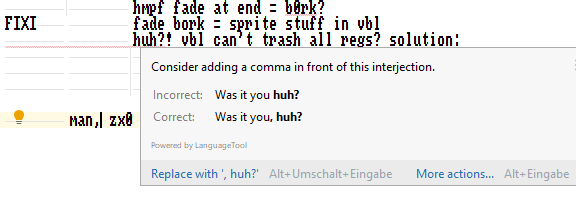
…suggesting a comma at the start of a sentence? Gimme a sec, I’m gonna check dat settings dialog real fastly…

I dunno, dis looks fine, dontcha think?
Good fuck with your improved eloquence!
The NSA has dropped two videos of internal lectures by Rear Admiral (then Captain) Grace Hopper from 1982:
- Future Possibilities: Data, Hardware, Software, and People Pt. I
- Future Possibilities: Data, Hardware, Software, and People Pt. II
You might know her as a groundbreaking computer scientist, author of the first compiler, inventor of COBOL, and for documenting the first “real” computer bug (a moth caught in a relay of the Mark II computer).
I always thought she also coined the term, but it turns out that “bug” has been used way earlier to denote a small mistake or design flaw. Anyhow, in my not-quite-factual history of Teletext in 420 Years of Teletext I credited her for the invention of programming bugs:
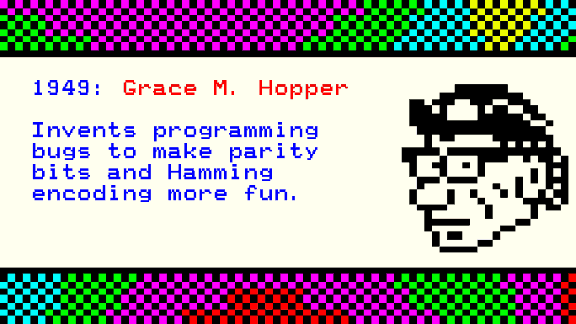
When drawing that little Teletext portrait I made sure to include her Navy hat which she is wearing in practically all photos you can find of her. Apparently that’s not a coincidence, she references it at the start of the lecture:
And if you’re wondering why I kept my cap on, I had a reason for that, too. It’s because this is my identifier.
And adds:
I hope you all know by now that every record in a computer system must have an identifier.
Heh, heh… Turns out Ms Hopper was quite the entertainer and a captivating presenter, and had a lot of innovative musings and some rebellious stories to share. Some random tidbits:
- Cars vs. transportation = computers vs. information flow (part one, 4:39)
- Story of the bug (17:51)
- “If anyone of you says ‘But we’ve always done it that way!’ I will instantly materialize behind you and I will haunt you for 24 hours” (25:14)
- Mark I computer referred to as “she” (32:55)
- “Common sense […] seems to be the last thing we use in connection with computers” (45:08)
- Easier to ask for forgiveness later, early computer hackers and security concepts, seperation of data by confidentiality level, systems of computers with specialized servers, interfaces and modularization, the cost of not doing something… – just watch the lecture already! :)
10/10, would watch again.

